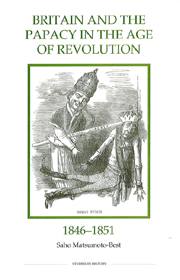Book contents
- Frontmatter
- Contents
- Dedication
- List of illustrations
- Acknowledgements
- Abbreviations
- Introduction
- 1 From 1815 to the election of Pius IX
- 2 The pope's liberal reforms, 1846–1847
- 3 The origins of the Minto mission
- 4 Britain and the 1848 revolution in Rome
- 5 Britain and the rise and fall of the Roman republic
- 6 The restoration of the Catholic hierarchy and anti-Catholicism in Britain
- Conclusion
- Bibliography
- Index
6 - The restoration of the Catholic hierarchy and anti-Catholicism in Britain
Published online by Cambridge University Press: 12 September 2012
- Frontmatter
- Contents
- Dedication
- List of illustrations
- Acknowledgements
- Abbreviations
- Introduction
- 1 From 1815 to the election of Pius IX
- 2 The pope's liberal reforms, 1846–1847
- 3 The origins of the Minto mission
- 4 Britain and the 1848 revolution in Rome
- 5 Britain and the rise and fall of the Roman republic
- 6 The restoration of the Catholic hierarchy and anti-Catholicism in Britain
- Conclusion
- Bibliography
- Index
Summary
The restoration of papal authority in Rome in 1850 led to new problems for the British government. Initially the difficulties were confined to the Italian peninsula where the pope's increasing conservatism led to a clash with Piedmont, which was trying to curb the power of the Catholic Church within its borders. The year 1850, however, was also to have domestic ramifications for Britain, for it saw not only the restoration of papal authority, but also the re-establishment of the Catholic hierarchy in England. It was no coincidence that these two incidents took place in the same year, for the return of the pope to Rome was a precondition for the achievement of Cardinal Wiseman's ambition.
Wiseman's elevation to the rank of cardinal and archbishop of Westminster was significant for British politics, for by provoking the spectre of a Roman Catholic threat to Britain, it had the effect of shifting the issue of papal temporal power from foreign to domestic affairs. Moreover, the timing of this move was highly unfortunate for the British government because at this point the question of the Queen's Colleges in Ireland was once again coming to centre stage and thus Britain needed to influence papal thinking on this issue. Torn between the desire to placate the domestic ‘no popery’ lobby and the need not to burn its bridges with Rome, Russell reacted to the re-establishment of the hierarchy by introducing the Ecclesiastical Titles Bill, beginning a legislative battle that would lead to the fatal weakening of his administration.
- Type
- Chapter
- Information
- Britain and the Papacy in the Age of Revolution, 1846–1851 , pp. 137 - 171Publisher: Boydell & BrewerPrint publication year: 2003



